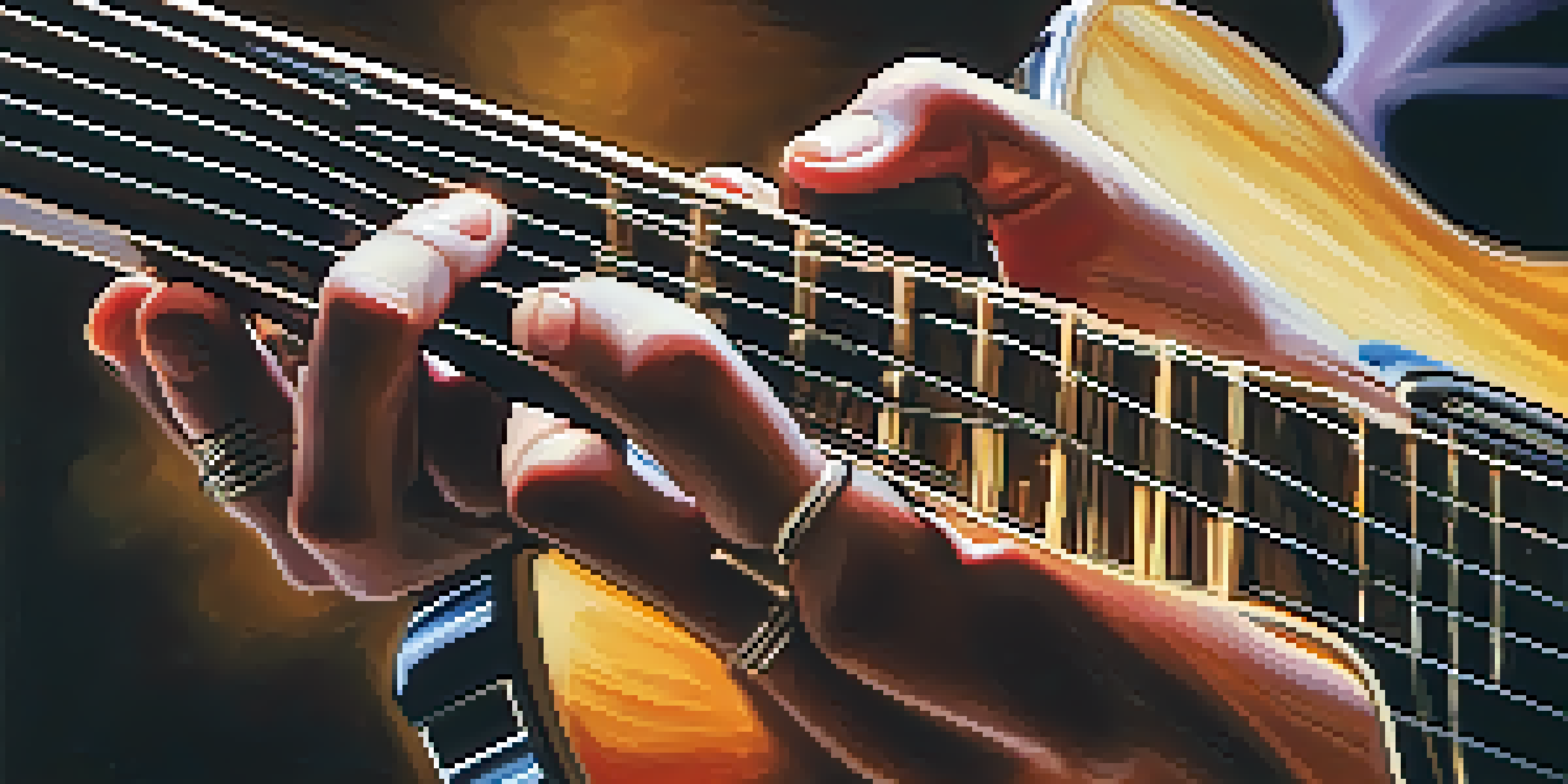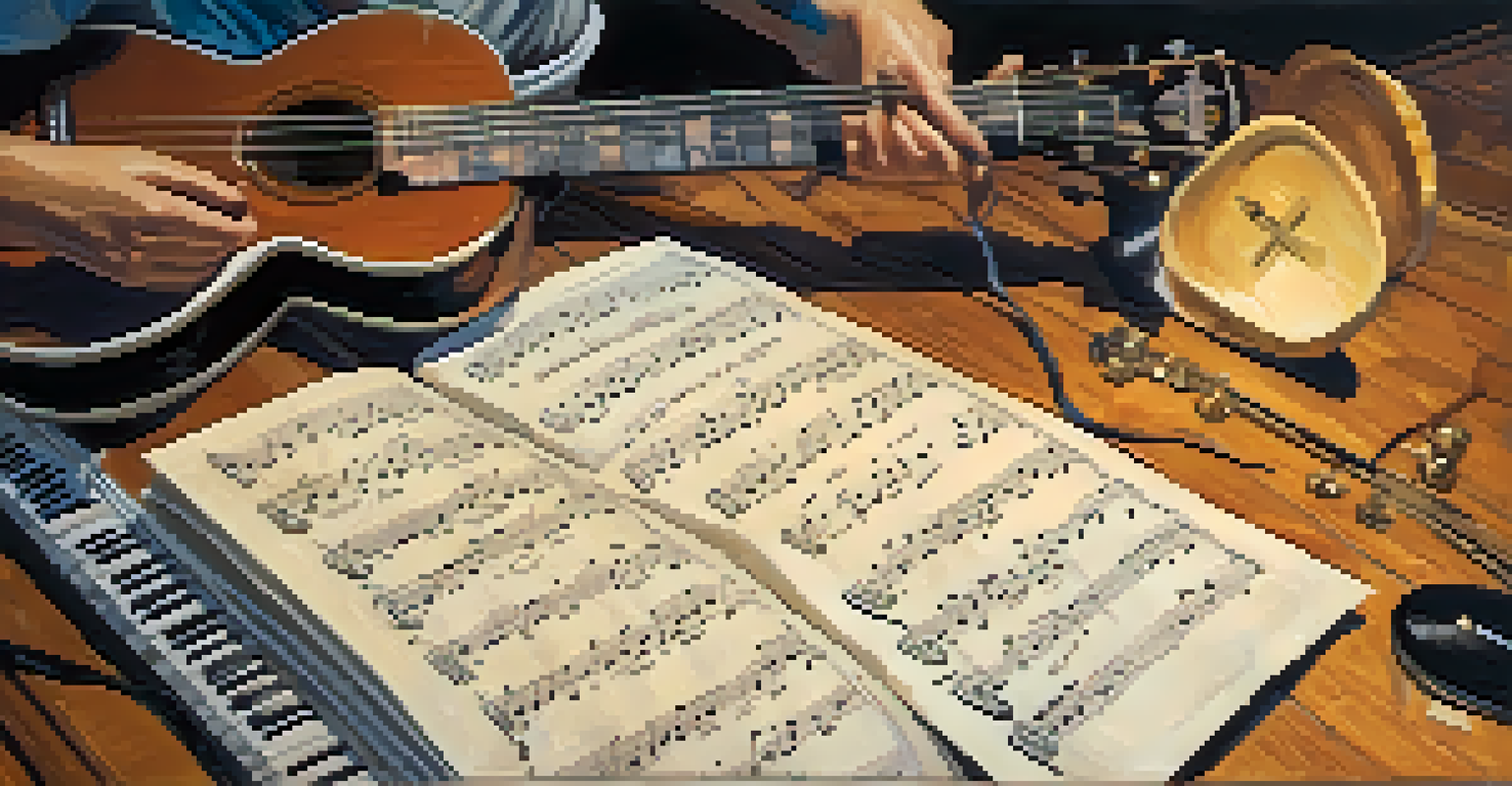Guitar Techniques for Enhancing Melodic Lines

Understanding the Importance of Melodic Lines
Melodic lines are the heart of any musical piece, giving it direction and emotion. They are the memorable parts that listeners hum long after the song has ended. By mastering melodic lines, you elevate your music, making it more engaging and expressive.
Music is the shorthand of emotion.
Think of a melody like a story; it has a beginning, middle, and end. When you play a captivating melodic line, you're not just hitting notes; you're telling a tale that resonates with your audience. This connection is what makes music powerful.
Incorporating strong melodic lines into your guitar playing can transform your compositions. It's essential to recognize their importance as you explore various techniques to enhance these lines further.
Using Bend Techniques for Expressive Melodies
Bending notes is one of the most expressive techniques available to a guitarist. By pushing a string up or pulling it down, you can create a sound that mimics the human voice, adding emotion to your melodies. This technique is especially effective in genres like blues and rock.

Imagine the feeling of a singer reaching for a high note. That same emotional pull can be achieved with guitar bends. Experimenting with different bend techniques can help you discover your unique sound and style.
Master Melodies with Expressive Techniques
Utilizing techniques like bends, hammer-ons, and vibrato can significantly enhance the emotional depth and fluidity of your melodic lines.
To integrate bends into your melodic lines, start with simple phrases and gradually incorporate more intricate bends. This will not only enhance your melodies but also build your confidence in using this powerful technique.
Incorporating Hammer-Ons and Pull-Offs
Hammer-ons and pull-offs are fantastic techniques for creating fluid, connected melodies. These techniques allow you to play multiple notes smoothly without picking each one, giving your lines a legato feel. This is particularly useful in fast passages or intricate solos.
Melody is the essence of music; it is the part that resonates with the listener’s soul.
Think of hammer-ons as a way to jump from one note to another with a single stroke, while pull-offs let you slide back down effortlessly. Together, they create a seamless flow, almost like dancing between notes.
To practice, try incorporating hammer-ons and pull-offs into scales or simple melodies. This will help you develop a comfortable technique and a better ear for how these embellishments can enhance your playing.
Exploring Vibrato for Emotional Depth
Vibrato adds a rich, emotional quality to your notes, breathing life into your melodic lines. By oscillating the pitch of a note slightly, you can convey feelings of joy, sadness, or longing. It's a subtle yet impactful technique that can turn a simple note into something profound.
Consider vibrato like the seasoning in a well-cooked dish; a little goes a long way. Too much can overpower the melody, while just the right amount enhances its flavor, making it more appealing to the listener.
Enhance Music with Arpeggios
Incorporating arpeggios allows for intricate melodic lines that add texture and depth, elevating your overall sound.
To develop your vibrato, practice varying the speed and width of your oscillations. This will give you versatility in your playing and allow you to express different emotions through your melodies.
Mastering Slides for Smooth Transitions
Slides are an excellent way to create smooth transitions between notes, making your melodic lines feel more connected. By sliding your finger from one fret to another, you can create a flowing sound that adds a unique character to your playing.
Imagine gliding down a hill; that's the feeling you want to replicate with your slides. They can add a sense of movement and excitement to your melodies, making them more dynamic and engaging to your audience.
To practice slides, start with simple two-note phrases and gradually work your way up to more complex sequences. This will help you develop a clean technique and improve the overall fluidity of your melodic lines.
Using Arpeggios to Enhance Melodic Lines
Arpeggios break chords into individual notes, allowing you to create intricate melodic lines that are harmonically rich. By playing the notes of a chord in succession, you can add texture and depth to your music that simple strumming cannot achieve.
Think of arpeggios as painting with notes; each note adds a layer of color to your melody. When used effectively, they can elevate your playing and bring a new dimension to your compositions.
Engage Audiences with Rhythmic Variation
Varying rhythmic patterns in your melodies keeps listeners engaged and adds dynamic interest to your playing.
Practice arpeggiating different chords and incorporate them into your melodies. This technique can help you develop a more sophisticated sound and improve your overall musicality.
Creating Melodic Variation with Rhythmic Techniques
Rhythm plays a crucial role in melody, and varying your rhythmic patterns can create interest and engagement in your playing. By experimenting with different note values and syncopation, you can transform a simple melody into something captivating.
Think of rhythm as the heartbeat of your melody; it gives it life and energy. Varying the rhythm can evoke different moods and keep the listener on their toes, wondering what comes next.

To explore rhythmic variation, try playing the same melody with different rhythms. This practice not only enhances your creativity but also helps you understand the relationship between melody and rhythm.